Dorley 1097: premiere was quite successful
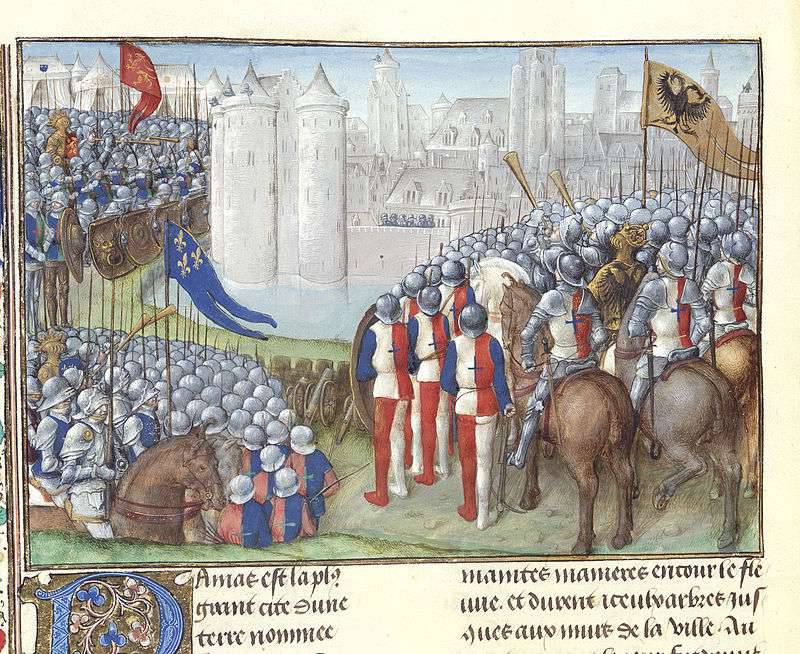
Crusaders besiege Damascus. Chronicle of d'Ernol Bernard le Trezot (end of 15 c.). British Library. Actually, 1097 miniatures of the year have practically not survived, and who would have painted them under the walls of Doriley?
As is known, the truth of the religious plans of the Crusaders was often questioned, although it is clear that faith played a significant role in the causes of actions and representatives of the nobility, and ordinary people who "took the cross" and set off to liberate Jerusalem. Undoubtedly, the nobility was impressed by the likelihood of ownership of land, and thus to consolidate in the East as sovereign lords, while less well-born pilgrims, of whom there were most, would have arranged just a change of their fate for the better.
The crusade at that time was not considered as a campaign, as such, that is, a military action, but as a pilgrimage, for participation in which the Crusaders, according to the pope’s assurances, abstained from all sins. Naturally, they could rely on material remuneration in the event that the outcome of the hostilities was successful. Urbane's call entailed a violent reaction: many of the major nobles of Western Christianity immediately "took up the cross" and began to gather forces for the campaign. Among the leaders was the elder brother of the King of England and the younger - the king of France, not counting other, no less significant leaders. The kings themselves did not have the right to go camping because they were under papal excommunication imposed on them for numerous sins!
Urban planned the beginning of the 15 crusade of August next year, on the feast of the Assumption of the Blessed Virgin Mary. Up to this point, the princes and other nobles were given time to collect funds and people for the upcoming campaign. Thus, four large coalitions gradually took shape. North French were headed by Count Robert II of Flanders, Duke Robert II of Normandy (brother of King William II of England), Count Etienne de Blois, and also Count of South de Vermandois, the younger brother of the French sovereign.
The Provencal group of knights was headed by Count Raymond of Toulouse, the main commander of the entire crusade (he considered himself as such, although, in fact, he was not - note. Aut.), And Ademar, Bishop of Le Puy, he is also the papal legate - the official representative of the pope Roman in the army of the Crusaders. The Lorraine crusaders were “supervised” by the local duke, Godfroy of Bouillon (de Bouillon) and his brothers Eustache III, Count of Boulogne (de Boulogne), and Baudouin (usually called Baudouin of Boulogne). In addition, a significant role was played by the Norman knights from southern Italy, headed by Prince Boemon Tarantsky and his nephew Tancred. All these groups set off each with their own route with the goal of meeting and uniting under Constantinople.
PEOPLE'S CROSS HALL
In addition to the armies assembled by the princes, spontaneous, less organized "troops" were formed, not recognizing any discipline and not accepting submission. The masses of commoners led by Peter the Hermit or the Hermit were the most famous of these "formations". And although this army was considered badly armed and practically deprived of an organization by a gathering of the poor, the “army” of 20 000 people. still included the core of 700 knights and other fighters. And although it was a battle of professionals, he lacked two important components - a good commander and material resources. The Crusaders of this wave arrived in Constantinople in August 1096, that is, before the better organized forces came from Europe, and, despite the warnings of the Byzantine leadership, they demanded that they be immediately transported to the Asian coast, dominated by the Seljuks. Haste, no doubt, was a consequence of the lack of centralized command and the influence of supply problems. Unfortunately for them, October 21 members of the people's crusade clashed with the Kilich-Arslan Seljuks. The pilgrims fought well until the knights, who succumbed to the ruse of the lightly armed Turkish cavalry who had turned to the feigned flight, were surrounded and killed.
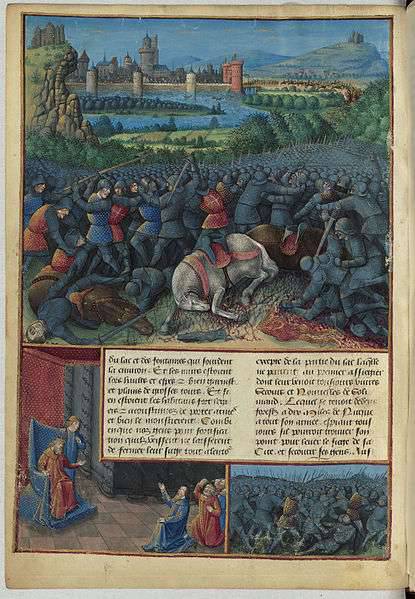
The siege of Constantinople by Christians in 1204. A miniature of their chronicle of Charles VII, Jean Cartier, near 1474 (sizes 32 × 23 cm (12.6 × 9.1 in)). National Library of France.
When the main combat detachment of the campaign and its leaders were taken out of the game, the remaining fighters and noncombatants turned into erratic flight, during which many died. About 3000 people escaped a general massacre and later joined the ranks of the First Crusade.
IN CONSTANTINOPLE
In the meantime, the other forces of the Crusaders marched in order to converge at Constantinople. The gathering lasted for several months, but Godfroy de Bouillon and the Lorraine crusaders arrived at the meeting site first, just on Christmas 1096. The last - at the end of April 1097 - the Boehon Tarantski reached the goal with the Normans from southern Italy and Raymond of Toulouse with troops from Provence and Languedoc. When the pilgrims approached Constantinople, serious disagreements arose between the main crusader and the Byzantine emperor Alexey I. In the end, with difficulty, agreement was achieved. The parties entered into an agreement regarding the fate of the territories, which, as expected, the Western pilgrims will win back from the Muslims. The treaty with the Byzantines was not an official union. Alexei had to take into account the complexity of the political situation, as well as the reaction of various Islamic states. And in the case of the failure of the crusader campaign, take into account the sad fate of the national crusade. As a result, military support from the imperial troops was limited. Nevertheless, the help of the emperor gave the crusaders a number of significant advantages.
The Byzantines provided military assistance, including a small army, led by the commander Tatikiah, who spoke as the representative of the emperor during the campaign. In addition, the Byzantines had small vessels that were used during the siege of Nicea. Indirect support was to provide information on the local political situation, geographical and topographical data, and information on the availability of weapons the adversary.
HIKE
Toward the end of spring, the crusaders "made" a detailed plan of "hostilities" against the Seljuk Turks. Knights-warriors gathered a huge army, numbering around 70 000 people. This, together with a large number of non-combatants (the so-called "attendants" troops). However, there were quite a few of them who had a weapon, knew how to handle it, and thus could, if anything, stand in one row with the soldiers and fight no worse than them. There were women among the troops: wives, maids and whores. Thus, the "army" turned out absolutely huge, and it was clear that such an army had not yet happened in the XI century. The army in terms of quantity was three to four times the size of the army of William the Conqueror, the one that invaded Britain 31 a year earlier.
It is 6 May 1067 of the year. The main goal of the campaign - the city of Nikaia, which at that time was the capital of the Rumsky sultanate of Kilich-Arslan, was reached. The Sultan himself at that time was in the east. Trying to somehow gain time in this difficult political situation, the Sultan wanted to seize the opportunity to capture the ancient Roman fortress of Melitena. But, having received news of the approach of the Crusaders to the walls of his native city, where his family remained, he was forced to go back.
NICKEY IN SADS
The Crusaders approached the walls of the city, and its siege began. Sultan was in no hurry to deploy the army for battle. This gave him the opportunity to either strengthen the military guard of the city, or to take the battle with the Christians in the field and thus force them to lift the siege. 16 May Kilich-Arslan attacked their army. They lined up, intending to block the passage through the southern gate of the city. At the beginning of the crusader squads missed the moment of striking, but the Provencal army managed to group and strike back at the enemy. In addition, the Turks are not lucky with the terrain. Attacking the Crusaders in the narrow gap between the city walls and the hills covered with thick forest, and not being able to quickly maneuver, Turkish horse archers suffered serious losses. The Crusaders, with strong equipment and superiority in physical strength, felt much more confident in battle and had more room to maneuver.
The defeated Sultan was forced to retreat, thus opening the way for the crusaders to the city walls. And a new wave of siege began. To capture the walls of the city, it was decided to use special mechanisms, and schemes for the construction of these machines and materials for their manufacture were provided by the Byzantines. The Crusaders also received ships to block the city from the lake, thus depriving defenders and citizens of the opportunity to import food and drinking water. In addition to building siege machines, the Crusaders took to dig a tunnel under the walls of the city.
When the battle began, the sultan's wife attempted to flee the city, but was captured by a Byzantine ship crew. Soon, the city’s defenders realized that the situation was hopeless and decided to tacitly surrender with the Greeks. The city was surrendered to Byzantine troops on the night of June 19.
AND AGAIN MARSH
Crusaders planned to move to Syria, Palestine and to their main goal - Jerusalem. The route was laid along the Byzantine military road leading south-east to Doriley, then crossing the Anatolian plateau and leaving in the direction of Syria. The route made it possible to establish relations with potential allies, the Christian principalities of Armenia, which could assist in the struggle against both the Turks and the Byzantines, the relations of the crusaders with whom they cracked immediately after Nikaia. The Crusaders did not waste time and continued the campaign at the earliest opportunity. Less than a week, as the first military units were removed from the scene. Given the size of the army and the absence of real command structures, the Crusader army was divided into two groups for convenience. Avant-garde, including the small Byzantine detachment Tatikia, consisted of no more than 20 000 people. The detachment consisted of Boemon Tarantsky, Tancred, Etienne Blouissky and Robert Normansky. The main forces following the avant-garde numbered over 30 000 people. These included detachments of Count Robert of Flanders, Godfroy of Bouillon, Raymond of Toulouse, and South de Vermandois.
Meanwhile, Kilich-Arslan made a regrouping of forces and teamed up with the Danish Turks, concluding an alliance with them. This gave his army an increase in 10 000 riders. The plan of the Sultan was to arrange an ambush for divided Crusader detachments.
Having chosen a convenient place, where the two valleys joined, the sultan decided to lure the knights into an open field and surround them just at that moment when the infantry could not cover them. Such tactics allowed the Turks to use their numerical superiority in the main sector of the battlefield, and horse archers - the space for maneuver. The Rumsky Sultan did not want to repeat the mistakes made under Nicaea.
DEPLOYMENT TROOPS
The crusaders learned about the approach of the Turks in the evening of June 30, although they, apparently, did not have exact data on the number of enemy troops.
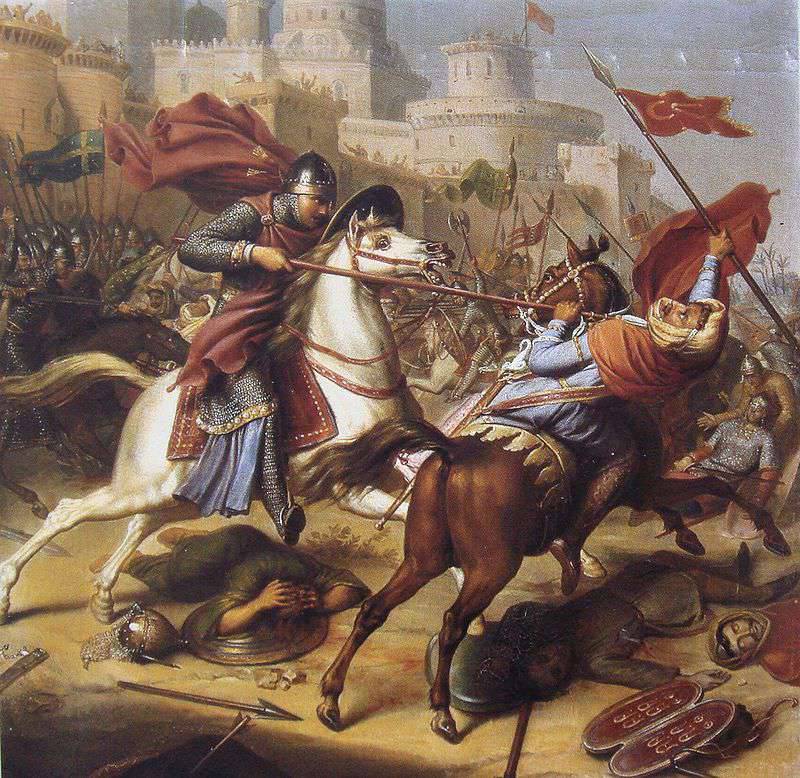
Robert of Normandy in the battle with the Muslims in 1097 – 1098 Picture by J. Dassi, 1850
The next morning, the vanguard of the Crusaders continued his speech on the plain. Then it became clear that the Turks are moving in large masses, approaching from the south. Expanding the plans of the Turks, the crusaders set up a camp, which at the same time could be a defensive base. It was erected by foot soldiers and non-combatants from the avant-garde, they also set up a camp at the exit to the plain of two valleys so that the marshy areas of the terrain cover the western approaches. Boemon put the mounted knights in front of the camp so that they blocked the way to the advancing Turkish horsemen. The main army of Christians was approaching from the west, but was still in 5 – 6 km from the avant-garde.
And DREAMED FIGHT ...
As soon as the Crusaders camped, the battle broke out. Boemon went against the Turks with the main core of mounted knights. In doing so, he played into the hands of the enemy. When the knights advanced, they came under fire from horse archers. Separated from the infantry that defended the camp, the knights could not converge in hand-to-hand combat with the nomads, and horse archers showered the enemy with a hail of arrows. Then a small part of the Turkish cavalry attacked the Christian camp and broke into it.
The cavalry of the crusaders was pushed aside to the southern tip of the camp, where the riders were gathered by Robert of Normandy. When order and order were restored, the knights were able to organize the defense of the southern corner of the camp, where the Turks did not have such room for maneuver as before.
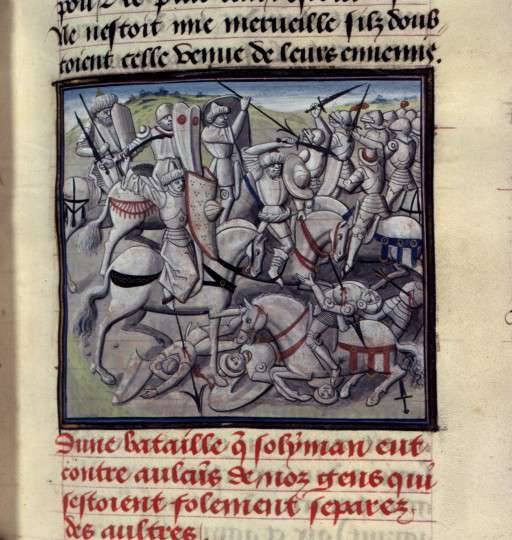
Battle of Dorilee 15's illuminated manuscript. "Continued stories, Guelmo of Tyr. National Library of France.
In the course of the battle, the crusaders began to gradually run out of steam. Fortunately for Boemon and all the others, around noon, help came from the Crusaders of the main squad. It took several hours for the knights of the main compound to arm themselves and cover the distance in 5 – 6 km, which separated the two contingents. The reason was the warriors who strayed from their troops and simply deserters who impeded the advancement of aid to the vanguard. The first detachment led by Godfroy de Bouillon. The knights attacked from the valley from the west, leaving the Turks in the left flank. At that moment, the latter were still fighting with the vanguard knights at the southern tip of the crusader camp. Inadequately protected, and sometimes completely unsupported, the Seljuk cavalry found itself between two forces of knights-crusaders, reliably protected by armor.
Subsequent reinforcements of the crusaders from the main body of troops under the command of Count Raymond passed through a line of drumlins (long ridges of hills and mountains — the effects of glacier creeping) scattered along the western edge of the plain. Such a natural cover allowed the crusaders to move unnoticed, and helped to enter the rear of the Turkish army.
The appearance of the enemy on this side turned out to be quite unexpected for the Turks, who had already suffered serious losses. Their army fled in panic. The battle ended, the persecution began, during which the crusaders plundered the enemy's camp. However, the losses on both sides were about equal: 4000 people from the Crusaders and about 3000 people from the Turks.
The scheme of battle.
The results ...
Dorile became a landmark place for the Crusaders. Yes, they were in danger due to the lack of a single command, allowing the enemy to attack himself already on the march. However, the Crusaders still had the ability to act cohesively, with a single force, which resulted in the first battle in the field.
The thought-out strategy of the battle was the result of the high leadership qualities of the princes of the Crusaders, able to respond quickly to new and unusual circumstances and serve as an authority for the soldiers. The battle of Dorilee opened the way for the Byzantines to liberate Anatolia, and the Crusaders allowed them to continue their march into Syria.
And a bit of a digit ...
Forces of the opposing sides
CROSSONS (approximately)
Knights: 7000
Infantry: more than 43 000
Total: more than 50 000
TURKS - SELDZHUKI (approximately)
Cavalry: 10 000
Total: 10 000
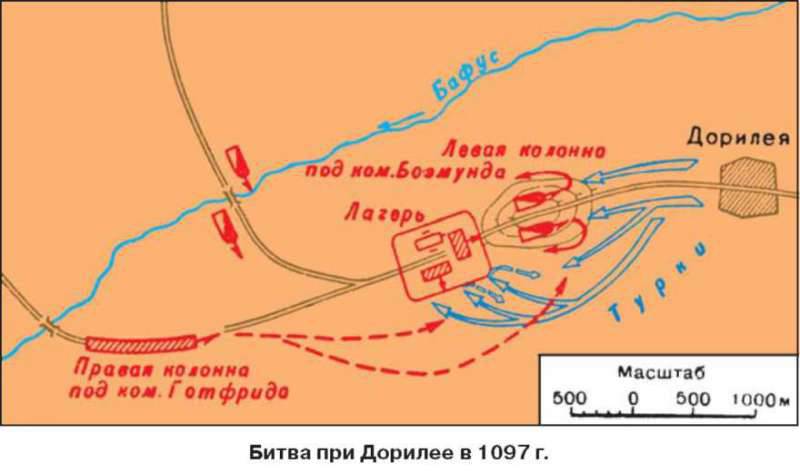
Information